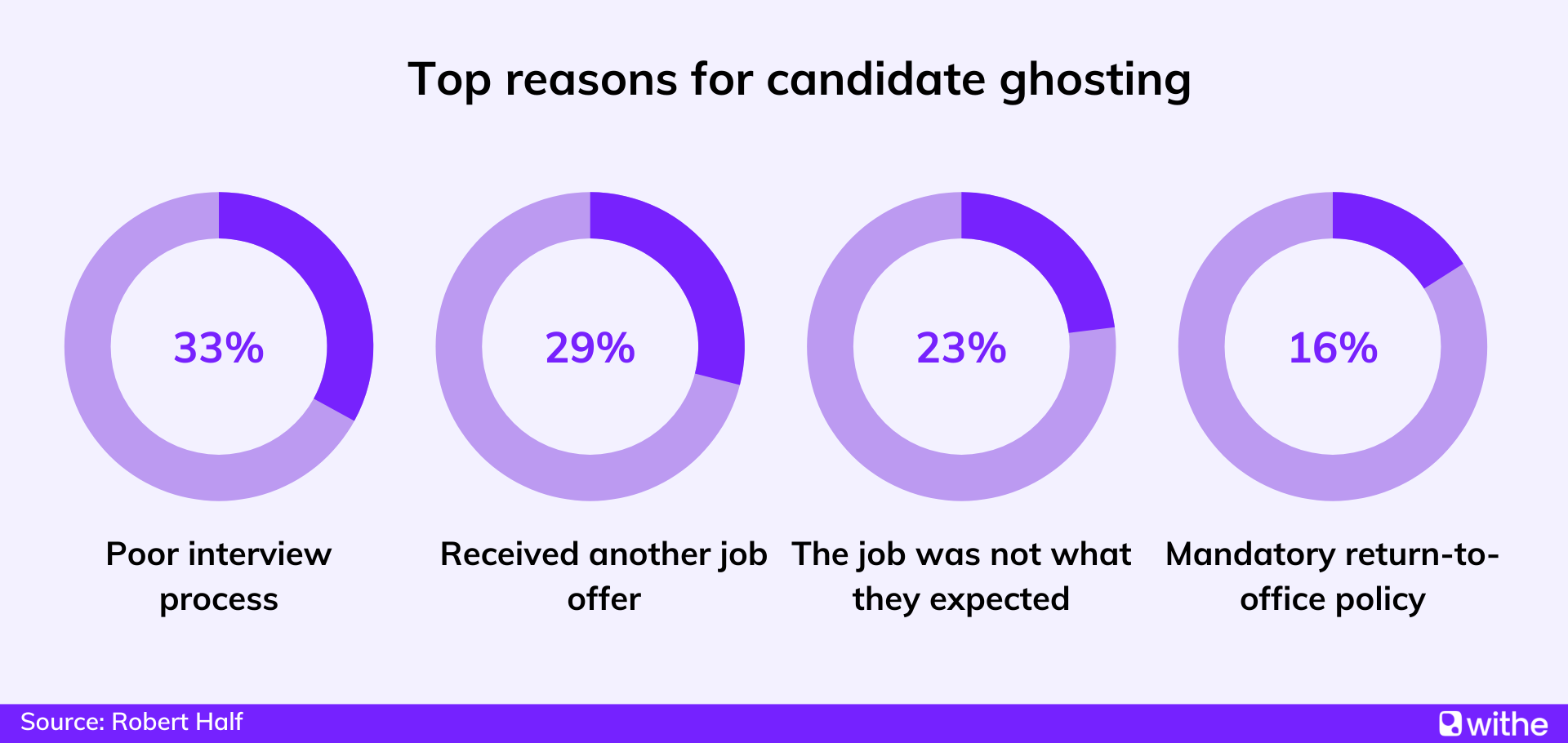Leverage Withe's hiring event platform
Streamline your seasonal and high-volume hiring process and hit your hiring targets.
Candidate ghosting has quickly become one of the most pervasive and disruptive challenges for recruiters across industries. Recruiters spend a lot of time and effort to execute hiring processes, and when their selected candidates stop responding or don’t show up for interviews, it can all feel like a waste.
The way we see it, candidate ghosting is partly a symptom of the current candidate attitude towards recruitment. It’s an attitude that’s informed by low unemployment rates, a lack of positive candidate experiences, and an extensive history of recruiters leaving interested candidates in the dark. As such, if recruiters want to prevent candidate ghosting and mitigate its impact, they need to take a proactive approach that meets candidates where they are.
In this article, we’ll dive into what candidate ghosting is, why it happens, and the steps recruitment teams can take to stop it from happening.
Leverage Withe's hiring event platform
Streamline your seasonal and high-volume hiring process and hit your hiring targets.
What is candidate ghosting?
The term “ghosting” comes from dating jargon and is used to describe someone who stops responding to texts, doesn’t show up for a date, and/or ceases all forms of communication without any warning.
Within the context of recruitment, candidate ghosting speaks to a similar situation in which a candidate suddenly stops engaging with the hiring process. This can happen at any point and in a number of ways. For example, a candidate could not respond to a request for a screening call after their application, or they could schedule an interview and then not attend. Candidate ghosting can even happen after the offer has been accepted — they simply don’t show up for their first day of work.
Candidate ghosting stats for 2023
While unfortunate, this trend is only growing in impact. Data from 2022 Robert Half research had 39% of employers claim that it was more common for job candidates to cut off communication than two years prior. The research also showed that those hiring for technology (48%) and administrative and customer support (42%) roles were mostly likely to report a surge in ghosting.
Meanwhile, according to a recent survey from Visier, 84% of job seekers have ghosted an employer in the 18 months prior to publication. This survey also found that higher level managers ghost at a particularly high rate:
- Directors — 91%
- VPs — 93%
- SVPs — 99%
- C-Suite — 96%
One reason behind this growth in candidate ghosting is that candidates have more options than they used to. It’s currently a candidate’s market, and recruiters are having to be more competitive than ever — and that means candidates can afford to drop off the face of the earth without compromising their job prospects.
Withe's hiring event platform helps recruiters meet with candidates 82% faster.
Why do candidates ghost recruiters?
Candidates will ghost recruiters for a number of reasons. Going back to the data from Robert Half, the top reasons include:
- A poor interview process (33%)
- Receiving another job offer (29%)
- The job was not what they expected (23%) — this could include anything from the role description to the salary and benefits
- There was a mandatory return-to-office policy (16%)

Other reasons listed out in the Visier survey include the salary being too low, inaccurate job descriptions, poor employer brand reputation, a frustrating hiring process, and a dislike of the perceived work culture.
Another possibility for ghosting is that the candidate may have had a change in professional circumstances within their current organization. This could include anything from a new role to an internal promotion, raise, or reorganization.
5 ways to avoid candidate ghosting in job interviews
Repeated candidate ghosting can have a significant negative impact on your recruitment team as it leads to wasted time, a lower return on investment, and a downward trend on important metrics like time to hire and time to fill. So, what can your team do to avoid candidate ghosting?
1. Consider your employer brand
Candidates should have a clear and informed idea of what life looks like at a company before they apply. If they have a good sense of the culture, the mission behind the brand, the type of work being done, and the type of people that work there — and they feel that all aligns with their career goals — they’ll be more likely to remain in the funnel. Take the time to build an employer brand that highlights and accurately reflects these features, and make sure that candidates aren’t surprised down the line. (A surprise might encourage them to ghost you.)
2. Add transparency into your recruitment process
Relatedly, you should also be transparent about the recruitment process itself. Be proactive in letting candidates know what they can expect, when they will hear back from you, and what the steps at each part of the hiring funnel look like. Again: avoid surprises. This will help keep them engaged as they go through the process.
Note: Before you do share your process, however, take the time to review it. Are there any places where you can save more time and avoid the opportunity for a candidate to drop off? Are there any steps that could benefit from an automated feature? Do you have enough human interactions included throughout? To put it simply, would you be willing to go through your company’s recruitment process? Make sure the process is streamlined by the time you share it with candidates so that they’re not turned off by it.
You should also be transparent about the potential career progression a candidate can expect if they are hired. This will allow them to look at the role from a longer-term perspective and envision what a future at your company could look like.
3. Host hybrid or virtual hiring events
Adding flexibility into your hiring process is always a good thing, especially when you’re looking to meet candidates where they are. By hosting hybrid or virtual hiring events, recruiters can do more to meet various candidate needs and keep them engaged in the hiring process. Plus, virtual and hybrid recruiting can also help expand your reach to more qualified candidates, therefore reducing the impact of candidate ghosting.
By using a hiring event platform like Withe, teams can schedule interviews faster, run more seamless hiring events, and easily track candidate performance, without removing the human factor. With such a positive experience, and the opportunity to form a human connection, candidates are less likely to be flippant about their relationship with the organization.
4. Prioritize the candidate experience
The candidate experience is another vital element here, as it can dictate whether a candidate ghosts or not. In fact, a whopping 83% of talent say a negative interview experience can change their mind about a role or company they once liked. Meanwhile, 65% of candidates have said that a bad interview experience can make them lose interest in a job. These negative experiences can ultimately lead to ghosting.
As you think about the candidate experience, think about it holistically. Find the right balance between AI tools that streamline and automate, and human interactions that foster relationships. A good rule of thumb is that automation should not replace human interactions during the hiring process, it should just streamline elements of it.
5. Get candidate feedback
Your candidates are your best source of feedback on the hiring process — whether they’re successful or not. Give them an opportunity to provide their thoughts on the candidate experience and the hiring process. Understanding where they may have faced friction or wanted for more communication will be key in refining your process and reducing the chance for candidate ghosting.
Get ahead of candidate ghosting
Whether it’s in dating or recruiting, ghosting isn’t fun. In the latter, it leads to wasted time and money, as well as a big dent in the talent pipeline. While it may be the candidates that are doing the ghosting, recruiters have a role in reducing its prevalence. Taking the time to revisit the hiring process, communicate effectively, and prioritize the candidate experience can go a long way in minimizing the impact.
Withe’s hiring event platform helps recruiters meet with candidates 82% faster. Learn more about our product.




